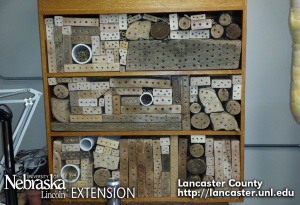
Rain barrel donated to our habitat project.
Some resources you may enjoy as you plan for spring! Be sure to include pollinator-friendly practices and habitats in your landscape plan:
What you can do right now! Now’s the time to start planning your insect and native bee habitat and nesting structures. We have some photos on the blog to help give you some ideas. From the February 2013 NEBLINE Newsletter (free) Attracting Pollinators to Your Landscape (includes directions to make a native bee nesting block) and Biology of Native Bee Pollinators. Grab those scrap pieces of lumber and start drilling!
Are your seeds OK? Have you been saving seeds for your garden? There’s a simple experiment to see if your seeds are still good. http://lancaster.unl.edu/hort/articles/2004/seedsaving.shtml
Need inspiration? Take a look at these photos from Benjamin Vogt. Vogt lives in Lincoln and has a 2,000 sq ft native prairie garden. It is absolutely beautiful. Here he documents his prairie garden through the year (with some other photos thrown in!) Enjoy The| Deep| Middle – Living and Writing in the Prairie Echo
Reading suggestions to help get you through this cold winter – from the Nebraska Statewide Arboretum’s blog “Beneficial Landscapes: the plants, wildlife, soil and water for our gardens” http://beneficiallandscapes.blogspot.com/
Add a Rain barrel – Try Harvesting Rainwater: We have a rain barrel for the Cherry Creek Habitat. Of course, it isn’t big enough to catch all the water run off – but it has been handy when we want to water specific plants. Consider adding a rain barrel and try other rainwater harvesting techniques this year! To help – UNL Extension has a brand new NebGuide. It provides information on how to use, install and collect rainwater. Rain barrels can be purchased or made. This publication is on-line and you can access it free! http://www.ianrpubs.unl.edu/epublic/pages/publicationD.jsp?publicationId=1612
Just announced! 2014 Artistic Rain Barrel Program: Prairie Theme! The Spring Creek Prairie Audubon Center and the City of Lincoln Watershed Management Division are collaborating on a project to educate the community on the benefits of using rain barrels to reduce rainwater runoff and improve water quality. Local artists are invited to paint prairie themed designs on a rain barrel to celebrate the role prairies play in filtering stormwater runoff. The deadline to apply to participate is February 7, 2014. http://lincoln.ne.gov/city/pworks/watrshed/educate/barrel/artist/
Landscape Sustainability: Sustainable landscapes describes landscapes supporting environmental quality and conservation of natural resources. For many people, a sustainable landscape is hard to understand or visualize. Other terms such as xeriscape, native landscape, and environmentally friendly landscape have been used interchangeably to describe sustainable landscapes.A well-designed sustainable landscape reflects a high level of self-sufficiency. Once established, it should grow and mature virtually on its own — as if nature had planted it. This UNL Extension publication is available on-line free http://www.ianrpubs.unl.edu/epublic/pages/publicationD.jsp?publicationId=203
Here’s to Sharing the Buzz!
Soni
UNL Extension provides research-based information to help you make informed decisions any time, any place, anywhere – http://lancaster.unl.edu










